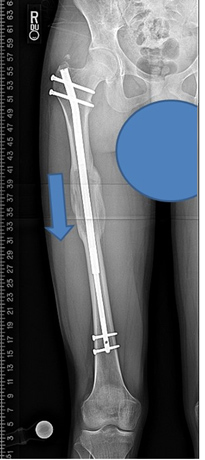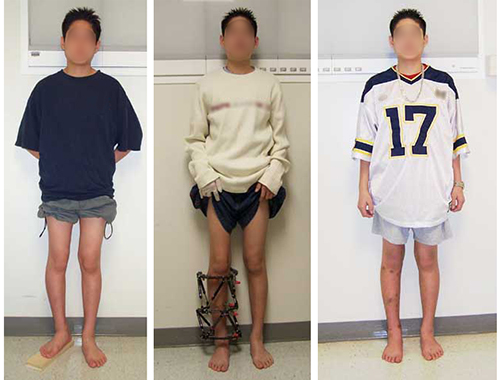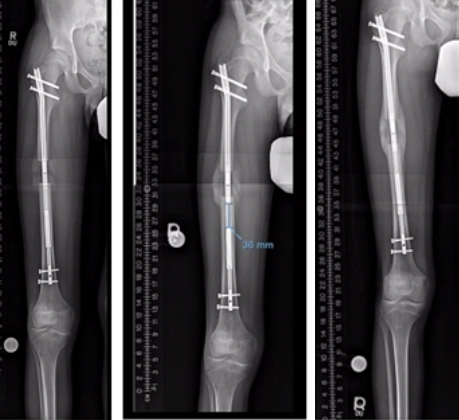Limb Lengthening Surgery
A limb length discrepancy, in which one arm or leg is shorter than the other, can make it challenging to walk or perform everyday tasks. A significant leg length discrepancy can also lead to other medical problems with the knees, hips or spine, such as functional scoliosis. Limb lengthening is a major advance in orthopedic surgery over recent decades that can equalize limb lengths and enhance people's mobility.

What is a limb length discrepancy?
Limb length discrepancy (also called anisomelia) is a condition where one arm or leg is shorter than the other. It can affect both children and adults. The lower limbs are more commonly affected than the upper extremities, and this is called leg length discrepancy or short-leg syndrome.
- Having legs of unequal length creates an imbalance in posture and gait (the manner in which a person walks) that places stress on the low back and hip. This, in turn, causes pain and joint degeneration, which can include premature osteoarthritis.
- Having arms of different lengths creates an asymmetry that can lead to back and shoulder pain.
What is limb lengthening surgery?
Limb lengthening surgery is an orthopedic procedure to help people who have one arm or leg that is shorter than the other. It uses the body's own capacity to regenerate new bone as well as the soft tissues, ligaments, blood vessels, and nerves that surround and support it.
The process begins with an operation called an osteotomy, in which the orthopedic surgeon cuts the bone to be lengthened. The limb (usually the upper or lower leg) is then stabilized using one of several different external and/or internal fixation devices or frames.
Two phases of recovery follow. In the first, or distraction phase, the bone that has been cut is very gradually pulled apart, in a process that promotes distraction osteogenesis or new bone growth at the site of the osteotomy. Continued growth of new bone tissue is accomplished by distracting or spreading the gap typically four times a day, one quarter millimeter (¼ mm) with each adjustment, for a total of one millimeter (1 mm) a day.

X-ray images of an osteotomy of the femur that was performed through a percutaneous approach. Gradual lengthening (8 cm) was accomplished with an internal lengthening nail to optimize leg lengths. Note the early new bone formation in the gap.
As the space between the ends of the bone opens up, the body continues to produce new tissue in the gap until the desired length of bone has been generated.
Additional strategies are available to correct any deformity that may be present, such as a misalignment of the bone resulting from trauma or a birth defect. Early on in this phase, patients walk with the aid of crutches in order to remain mobile.
During the second phase of treatment, the bone consolidates and heals. The patient gradually puts more weight on the affected limb, and starts walking without any assistance.
The gradual process of lengthening can be accomplished with either an external fixator or an internal lengthening nail.
External fixation is a frame built on the outside of the limb connected to the bone via pins (rods), screws and wires. Adjustments to the external fixator can be used to gradually lengthen and straighten the short and malaligned limb.


An adult patient, before and after limb lengthening surgery.
The internal lengthening nail (ILN) is a telescopic, motorized intramedullary nail or rod that is inserted into the marrow cavity of the bone. With a remote control device, the magnet in the nail is rotated and this gradually elongates the telescopic nail and the bone.
With this method, the bone is straightened at the time of surgery when the ILN is inserted, and the lengthening is then done gradually over the next several weeks.
How does limb lengthening work?
Limb lengthening works by cutting a bone in half and then separating the two sections to allow new bone to grow into the space between them.
The limb lengthening and deformity correction process works on the principle of distraction osteogenesis. This revolutionary surgical concept that reversed the long-held belief that bone could not be regenerated. Bone has a natural ability to regenerate (grow more bone) after fracture or after it is surgically cut (osteotomy). Limb lengthening surgery takes advantage of this mechanism, which is called osteogenesis.
The complete process involves three steps:
- An osteotomy (bone cut) is performed to divide the bone in two.
- The two bone segments are slowly distracted (pulled apart) at a controlled rate and rhythm by means of internal lengthening nails or external fixators.
- New bone fills in the gradually enlarging gap that is created.
In this way, bone segments can be lengthened by 15% to 100% of their original length. Bone is usually lengthened at rate of about one millimeter (1 mm) per day.
The lengthening phase of treatment (distraction) is followed by mineralization and hardening (consolidation) of the new bone. Soft tissues including skin, muscles, nerves, blood vessels stretch and grow during this process.
What types of limb lengthening surgery are possible?
The gradual process of lengthening can be accomplished with either an external fixator or an internal lengthening nail.
External fixation is a frame built on the outside of the limb connected to the bone via pins (rods), screws and wires. Adjustments to the external fixator can be used to gradually lengthen and straighten the short and malaligned limb. We use both monolateral (one-sided) and circular external fixation devices, depending on the patient.

Pediatric patient before surgery, wearing the external fixator for leg lengthening, and after surgery.
The internal lengthening nail (ILN) is a telescopic, motorized intramedullary nail or rod that is inserted into the marrow cavity of the bone. With a remote control device, the magnet in the nail is rotated. This gradually elongates the telescopic nail and the bone in which it is inserted. With this method, the bone is straightened at the time of surgery when the ILN is inserted, and the lengthening is then done gradually over the next several weeks.

X-ray images of limb lengthening patient with internal nail lengthener at five weeks, where the bone has grown to desired length, at two months with bone growth consolidating, and at three months with completely healed bone.
What is the best method for limb lengthening?
Whenever possible, we prefer to use an internal lengthening nail. However, there are many situations that require use of the external fixator, including:
- children with open growth plates
- small bones of the foot, hand and arm
- large deformities that cannot be straightened acutely
What is the recovery time for limb lengthening?
The exact duration depends on the amount of lengthening needed, but most people are walking without crutches after about two to three months.
There are two phases of recovery:
- the lengthening (distraction) phase
- the bone healing phase
During the lengthening phase, patients are mobile and walking with crutches. They also do daily exercises to maintain joint mobility and muscle strength.
The recovery process gets much easier once the bone has grown to the full desired length. There is a gradual increase in weight bearing, and most people are walking without crutches after about two to three months.
The speed of bone healing is a function of age. Children, generally, experience faster bone healing than do adults. Nevertheless, adult patients even in their 60s have had successful limb lengthening outcomes.
Video: Limb lengthening patient story
Ian Gillen was an athlete on his way to play Division I basketball, until he was diagnosed with a large bone tumor in the middle of his tibia, resulting in doctors removing 17cm of bone from his leg. Ian turned to the doctors at Hospital for Special Surgery to help him get back onto the basketball court. This video follows Ian through his limb lengthening reconstruction and recovery process.
Overview articles on limb lengthening
Get a deeper dive on limb lengthening in these articles.
Articles on conditions and issues related to limb lengthening
Read about conditions related to limb length discrepancies and limb deformities.
 Limb lengthening articles for healthcare professionals
Limb lengthening articles for healthcare professionals
Updated: 8/30/2022
Reviewed and updated by S. Robert Rozbruch, MD
References
- Fragomen AT, Fragomen FR. Distal femoral flexion deformity from growth disturbance treated with a two-level osteotomy and internal lengthening nail. Strategies Trauma Limb Reconstr. 2017 Nov;12(3):159-167. doi: 10.1007/s11751-017-0298-2. Epub 2017 Oct 16. PMID: 29039128; PMCID: PMC5653604.
- Galal S, Shin J, Principe P, Mehta R, Khabyeh-Hasbani N, Hamilton A, Fragomen A, Rozbruch SR. Humerus Lengthening: A Comparison of the Internal Lengthening Nail to External Fixation. HSS J. 2021 Jul;17(2):207-212. doi: 10.1177/1556331621996334. Epub 2021 Mar 4. PMID: 34421432; PMCID: PMC8361582.
- Goodbody C, Blyaker A, Widmann R, Dodwell E. Limb Lengthening Using the Ilizarov Method or a Monoplanar Fixator. In Operative Techniques in Pediatric Orthopaedics. Edited by Flynn JM and Wiesel SW. Wolters Kluwer. New York, NY, 2021.
- Goodbody CM, Buksbaum J, Harbison MD, Fragomen AT, Rozbruch SR. Limb Lengthening in Russell-Silver Syndrome: An Update Confirming Safe and Speedy Healing. J Pediatr Orthop. 2021 May 13. doi: 10.1097/BPO.0000000000001855. Epub ahead of print. PMID: 33999566.
- Hamdy RC, Bernstein M, Fragomen AT, Rozbruch SR. What's New in Limb Lengthening and Deformity Correction. J Bone Joint Surg Am. 2018 Aug 15;100(16):1436-1442. doi: 10.2106/JBJS.18.00584. PMID: 30106829.
- Rozbruch SR, Hamdy R, eds. Limb Lengthening and Reconstruction Surgery Case Atlas. Cham: Springer International Publishing: Imprint: Springer; 2020. doi:10.1007/978-3-319-02767-8
- Rozbruch SR, Kleinman D, Fragomen AT, Ilizarov S. Limb lengthening and then insertion of an intramedullary nail: a case-matched comparison. Clin Orthop Relat Res. 2008 Dec;466(12):2923-32. doi: 10.1007/s11999-008-0509-8. Epub 2008 Sep 18. PMID: 18800209; PMCID: PMC2628243.
- Rozbruch SR, Pugsley JS, Fragomen AT, Ilizarov S. Repair of tibial nonunions and bone defects with the Taylor Spatial Frame. J Orthop Trauma. 2008 Feb;22(2):88-95. doi: 10.1097/BOT.0b013e318162ab49. PMID: 18349775.
- Rozbruch SR, Ilizarov S, Blyakher A. Knee arthrodesis with simultaneous lengthening using the Ilizarov method. J Orthop Trauma. 2005 Mar;19(3):171-9. doi: 10.1097/00005131-200503000-00004. PMID: 15758670.

